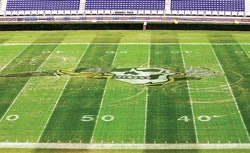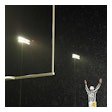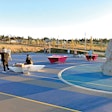There's something about a home sports field that brings out feelings of pride and protectionism - defending one's own turf, if you will - and not just during games.
 TIME TO FIX THE DOUGHNUTS Damage to the East Carolina University football field required an extra day of care. (Photo by The Daily Reflector)
TIME TO FIX THE DOUGHNUTS Damage to the East Carolina University football field required an extra day of care. (Photo by The Daily Reflector)Consider what East Carolina University head football coach Ruffin McNeill told WNCT in Greenville, N.C., after three individuals took three Kubota utility vehicles for a 3 a.m. joy ride through Dowdy-Ficklen Stadium one Sunday last October. "Dowdy-Ficklen is precious to me, having played and bled on that thing," McNeill said. "It's really disappointing that someone would do that to our house. That's our house. It's all of our house. We live here."
And note the possessive tone in Joey Perry, ECU's director of athletic grounds, as he describes the damage done. "They tore up four or five porcelain water fountains, ran through some concessions stands and wrecked all three machines," Perry says. "In the meantime, they got on the field with all three machines. They did doughnuts and slung the machines around all over my field."
In the end, most of the $40,000 worth of damage was structural, but Perry put in an extra 15 hours preparing the playing field for a televised home game against Navy the following Saturday. "Cosmetically, it was awful," Perry says of his first impression of the field damage. "But as far as playability, all they really did was shear off the leaf blades. Those machines are heavy, but they're not heavy enough to really get into the actual root zone."
Perry was fortunate. Three other incidents of field vandalism in October involved heavier machinery. One baseball field serving the Wells-Ogunquit (Maine) Little League and an adjacent youth football field were damaged by car tracks, and a car driven onto the football field at Thomas Jefferson High School in Richmond, Va., left tire marks and divots across 60 yards of turf - this, a mere five days after a car damaged the field at rival J.R. Tucker High School.
And the sense of violation is every bit as real even when the field under attack is synthetic. In September, a Little Rock (Ark.) High School student confessed to spray painting a vulgar image on the new football field at Catholic High School, along with the score of the previous night's game between the schools and the words "Father Tribou" - in reference to Catholic's longtime principal who died 10 years ago. School officials were left to contemplate whether to scour the field with chemicals or replace the affected section at a cost of $10,000. Not surprisingly, current principal Steve Straessle told KARK in Little Rock that he was upset. "The boys are appalled, as well," Straessle said. "They have a lot of pride."
Mike Goatley - in an otherwise proud fatherly moment - stood at the 50-yard line with his wife and daughter, the Blacksburg (Va.) High School homecoming queen, three Octobers ago. Under their feet was an enormous rectangle spray-painted green. Under that was a phallic symbol burned into the turf with some type of fuel. "That was right where we were standing, and so we talk about it to this day," says Goatley, professor of crop, soil and environmental sciences and extension turfgrass specialist at Virginia Tech University and the current president of the Sports Turf Managers Association. "We still have a chuckle about that, because they obviously had to take some colorants and paint over it. The entire school knew what had happened. They did take the corrective measures to mask it over, so at least the opposing team didn't know what it was, although maybe the opposing team was involved in it."
The long-term fix was a more serious matter, according to Goatley, who lent his expertise to the situation. "The challenge was how to get the grass to grow back in there at the end of the season," he says. "So we really had to flush that thing out. We core aerated and irrigated it like crazy and promptly opened that soil up, and we were able to get grass seed germinating and growing again."
Most turf vandalism involves two challenges - getting a field playable (if not presentable) for the next contest, which might be days away, and then restoring it to horticultural normalcy, a process that could take months, depending on the chosen mode of destruction.
The greatest threat to immediate playability is the rutting caused by tire tracks, which pose the greatest threat to athlete safety. In those cases, maintenance staff can manually sink pitchforks into the ruts and break up the soil in an effort to raise the soil level to match that of the surrounding unharmed field. Then, ideally, the field is rolled in an effort to ensure stable footing. "It sounds almost counterintuitive," Goatley says. "You fluff it up to level it out so there isn't a rut that would be a tripping hazard, and then you firm it up for footing after the fact, because you don't want somebody whose foot hits that to get an ankle injury."
Intuition only goes so far when foreign material is introduced to the playing surface. Fuel causes nearly immediate death to the turf plant, but it leaves a telltale odor. The maintenance professional at least knows what he or she is dealing with. "That tells me it's something we can probably leach through soil and we can restore that grass over time," Goatley says.
The more difficult diagnosis comes when the grass is dead but odorless. Says Goatley, "You can't just look at that and say, 'Oh, that's such-and-such herbicide that's been put out here.' Again, I tell people to get the field in condition to play as fast as they can, but they need to know what's there."
An affordable way to at least begin the diagnostics is to take a soil sample, place it in a warm, moist environment (for example, on a windowsill), add seed and monitor its germination. "If you can't get anything to germinate, you suspect it might be a pesticide," Goatley says. "In just a few days you ought to be able to get some grass seed to pop, and if it lives, that's a good sign. If it doesn't live, that means you might have a pesticide out there and you might have to extract that soil. That's probably one of those situations where you might pay a little bit more to get some lab testing done to find out what was done to the field."
With herbicides and pesticides, it may very well be next year before the field is back to normal. Soil extraction and replacement, something Goatley says he's never personally witnessed, might be avoidable. "It depends on the pesticide," he says. "There are some things that might be able to be leached through."
Another strategy, albeit a drawn-out and difficult one, is to apply activated charcoal to the affected areas. "That will bind the pesticide," says Goatley. "Typically, you have to remove the sod, apply a specified rate of activated charcoal, till it into the soil, and then either seed or sod on top of that. The charcoal is basically acting as an absorbent."
For ECU's Perry, defending his turf now means locking it down. "I have four gates leading to my football field," he says. "I have changed all the locks on the field gates, and there are only a certain number of people who have those keys. Now, if vandals are going to get on the field, they're going to have to make an effort."
That should spare Perry some effort. By 11 a.m. the day the damage to his field was discovered, he was on site, mowing the field in two different directions, blowing it and rolling it. He filled in some particularly bad spots with sand and top-dressing, then climbed the stands to get a bird's-eye view. "You know, it looked like it had been in a catfight," says Perry. So he took some turf pigment, mixed in a little gold to dull the brightness, and covered the areas where blades had been lost to spinning tire treads. "I just kind of played with it until it matched the actual color of the grass," he says.
Not a typical Sunday for Perry, who usually leaves the field untouched for those 24 hours, but it could have been worse. (Not knowing what to expect, he had actually called around to assess sod availability.) And it will only get better. "My rye grass is kind of peeking back through some of those spots now to help cover it up," he says. "I'll just deep-tine aerate like normal in June after graduation, and we'll top-dress, and you'll never see those marks again."

































